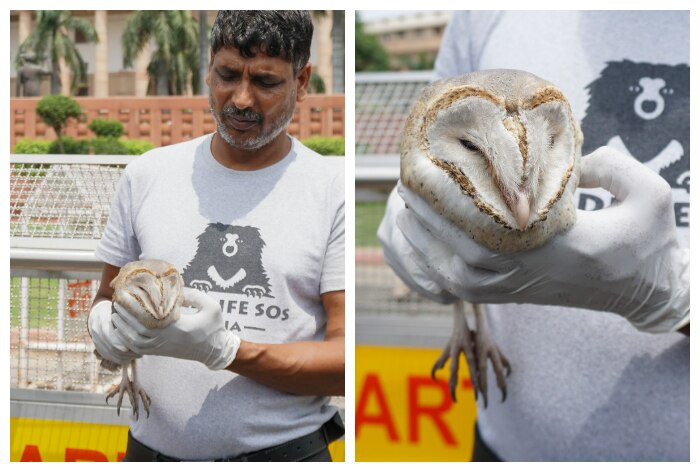
Ailing Monkey Seeks Shelter In Parliament House, Rescued By Wildlife SoS

Barn Owl Rescue: A barn owl, found with an injury on its wing inside the Parliament building in New Delhi, has been successfully rescued by the Wildlife SOS Rapid Rescue Unit. The bird has been transferred to Wildlife SOS’ rescue facility and is currently under medical observation.
Vigilant staff members spotted an injured barn owl on a lawn inside the Parliament premises. The bird had fallen from a tree and was found with an injury on its right wing. Recognising the urgent need for assistance, the concerned individuals promptly contacted the 24-hour Wildlife SOS emergency rescue helpline (+91-98719 63535). Responding to the distress call, Wildlife SOS dispatched a team of experienced rescuers to the location.
The rescue team, equipped with the necessary gear, took the barn owl under their care. The owl was promptly transferred to the Wildlife SOS rescue facility for immediate medical attention and treatment. The organisation’s dedicated veterinary team is now working diligently to rehabilitate the injured bird and ensure its recovery.
Kartick Satyanarayan, Co-founder & CEO, Wildlife SOS, said, “For barn owls and other birds of prey, the ability to fly is essential for hunting and survival. An injured wing can make it difficult for them to catch prey or escape predators. Wildlife SOS’ rehabilitation efforts aim to heal the injured wing of the bird as much as possible, ensuring its eventual release into its natural habitat.”
Wasim Akram, Director-Special Projects, Wildlife SOS, said, “We are grateful to the rescue caller for contacting Wildlife SOS and showing empathy towards the bird. The Wildlife SOS Rapid Response Unit provides round-the-clock service across Delhi-NCR to rescue and relocate wildlife that is injured, in distress or caught in conflict situations.”
The barn owl (Tyto alba) is the most widely distributed species of owl in the world and one of the most widespread of all species of birds, being found almost everywhere except for the polar and desert regions, Asia north of the Himalayas, most of Indonesia, and some Pacific Islands. It is also known as the common barn owl, to distinguish it from the other species in its family, Tytonidae, which forms one of the two main lineages of living owls, the other being the typical owls (Strigidae).
The Barn owl does not hoot but utters an eerie, drawn-out screech.
Barn Owls do not clean or chew on their food, they prefer to swallow it whole with the skin and bones still included. As a result, they cough out pellets of indigestible matter which is made up of the skin and bones of their prey that they just consumed.
Barn Owls place their nests in the holes of trees, cliff ledges and crevices, caves, burrows, and manmade structures such as barns, nest boxes, haystacks, and other buildings.
Barn Owls are nocturnal hunters as they have evolved to hunt in total darkness. They are able to do this because their wings don’t make any noise while they fly and they have remarkable hearing. They are capable of picking up the faintest of noises due to their uneven ears. Barn Owls can find prey underneath covers like grass and snow whilst flying in the air.
Like other owls, Barn Owls have ears placed at different levels on the side of their head. Since their ears face different directions, they can locate the source of a sound accurately without having to turn their head. The small cover of feathers over their ears also helps them in directing sound into their ears, thereby enhancing their already powerful hearing.
Their eyes have adapted to centuries of hunting in absolute darkness. They can find prey in the dark with their night vision with ease, making them a formidable predator at night.
(Facts by birdwatchingacademy.com)
For breaking news and live news updates, like us on Facebook or follow us on Twitter and Instagram. Read more on Latest Delhi News on India.com.
Enroll for our free updates
